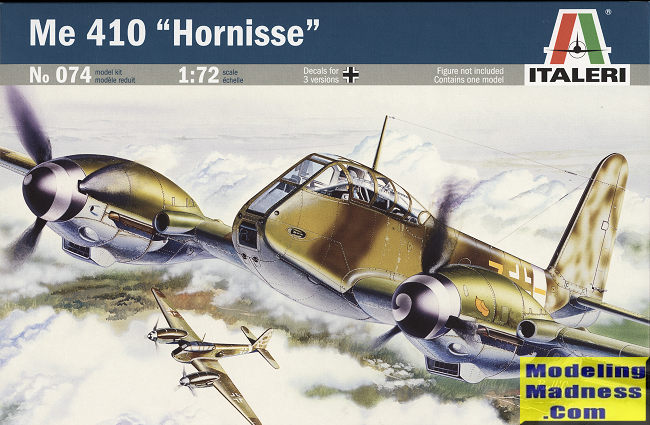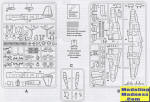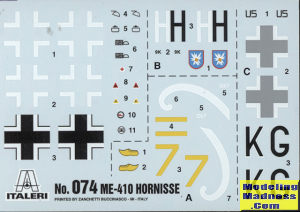
Italeri 1/72 Me-410 Hornisse
| KIT #: | 074 |
| PRICE: | $19.99 SRP |
| DECALS: | Three options |
| REVIEWER: | Scott Van Aken |
| NOTES: |

| HISTORY |
Operational History
The Me 410 night bomber proved to be an elusive target for the RAF night fighters. The first unit to operate over the UK was V./KG 2, which lost its first Me 410 on the night of 13–14 July 1943, when it was shot down by a de Havilland Mosquito of No. 85 Squadron RAF.
The Me 410 was also used as a bomber destroyer against the daylight bomber formations of the USAAF, upgraded with Umrüst-Bausätze factory conversion kits, all bearing a /U suffix, for the design — these suffixes could vary in meaning between subtypes. As one example, the earlier Me 410 A-1/U1 designation signified a camera-fitting in the under-nose ordnance bay for reconnaissance use (as the A-3 was meant to do from its start), while the same /U1 designation or the later Me 410 B-2 signified a mount of a pair of the long barreled, 30mm calibre MK 103 cannon in the undernose ordnance bay. The /U2 suffix designated a fitment of two additional 20 mm MG 151/20 cannons in the under-nose ordnance bay instead — the A-1/U4 subtype fitted the massive, 540 kg (1,190 lb) weight Bordkanone series 50 mm (2 in) BK 5 cannon, loaded with 21 rounds in the same undernose ordnance bay in place of either the /U1's cameras or MK 103s, or the /U2's added pair of MG 151/20 autocannon. For breaking up the bomber formations, many Me 410s also had four underwing tubular launchers, two per wing panel, firing converted 21 cm (8 in) Werfer-Granate 21 infantry barrage rockets. Two Geschwader, Zerstörergeschwader 26 and 76, were thus equipped with the Me 410 by late 1943.
They were moderately successful against unescorted bombers through 1943, with a considerable number of kills against USAAF day bomber formations being achieved. So effective were the 410s and 110s with the 21cm missiles that the USAAF basically stopped deep penetration raids in October of 1943 and seriously considered stopping the daylight bomber offensive as the losses were so high. In early 1944, when the Mustang first started escorting bombers, the Me 410 formations encountered these fighters protecting the bomber streams deep into Germany, usually flying far ahead of the combat box formations as an air supremacy move in clearing the skies of any Luftwaffe opposition. This resulted in the Me 410's previous successes against escorted bombers now often being offset by their losses. An example of this — as part of a campaign started two days earlier by the USAAF — was on 6 March 1944 during an attack on Berlin by 750 8th AF heavy bombers, when 16 Me 410s were shot down in return for eight B-17s and four P-51s (which were destroyed by Bf 109 and Fw 190 fighters escorting the Me 410s). The following month on 11 April, with 8th AF raids hitting Sorau, Rostock and Oschersleben, II./ZG 26's Me 410s accounted for a rare clear success, initially bringing down 10 B-17s without any losses. During the course of the same raid, their second sortie was intercepted by P-51s that destroyed eight Me 410s and three Bf 110s. Sixteen crewmen were killed and three wounded.
From mid-1944, despite being Hitler's favourite bomber destroyer, the Me 410 units were taken from Defence of the Reich duties and production was phased out in favour of heavily armed single-engine fighters as dedicated bomber destroyers, with the Me 410s remaining in service flying on reconnaissance duties only. Some Me 410s were used with Junkers Ju 188s during the Battle of Normandy, for high-altitude night reconnaissance.
| THE KIT |
 In
1/72, the Me-410 has been produced by Frog, Lindberg, Revell, Matchbox, Fine
Molds, and Italeri. Only the latter two are what one would call 'modern' tooling
with engraved panel lines. Italeri's kit was released in 1999, however it was
only released as a single variant, the A-1 while Fine Molds has done a whole
series. I have built the Revell and Fine Molds kits finding both to be fairly
straight-forward. I won't comment on accuracy as I don't really care all that
much about nuances, but this one looks to be right.
In
1/72, the Me-410 has been produced by Frog, Lindberg, Revell, Matchbox, Fine
Molds, and Italeri. Only the latter two are what one would call 'modern' tooling
with engraved panel lines. Italeri's kit was released in 1999, however it was
only released as a single variant, the A-1 while Fine Molds has done a whole
series. I have built the Revell and Fine Molds kits finding both to be fairly
straight-forward. I won't comment on accuracy as I don't really care all that
much about nuances, but this one looks to be right.
Typical of the scale, the cockpit is a tub with molded in rudder pedals. Apparently Italeri hadn't picked up on the fact that most modelers in this scale like decals for instruments as these are simply raised circles and the builder has to paint them. There are pilot and gunner seats and there is a rear bullhead with radio faces on it. This gets placed in a fuselage half and the halves closed around it.
In the fuselage one then installs the side guns and attaches the separate nose and the tailplanes. Wings are then built up with whatever holes you wish to open being done at this time. Also attached are the radiator faces and the upper wheel well pieces. Engines appear to be handed and one builds these up, including the spinner backing plate if one wishes the props to turn. Landing gear is quite sturdy and there is only a small main gear door as the larger doors only open during retraction/extension.
The canopy in in two halves to allow for the proper shape
and is such that you cannot open any panes. You have a couple of options
regarding the lower nose mounted bomb bay. Two of the options have this closed
and so you have a single piece for that. The third option has them open,
providing a view of two large bombs installed therein. The sprues also have
smaller bombs and wing racks, but these are not used. Having the bay doors open
means cutting the single piece mentioned earlier. For things under wings you
have a dual 21cm rocket la uncher
for each wing or a drop tank and rack. These will be used depending on which
marking option you choose.
uncher
for each wing or a drop tank and rack. These will be used depending on which
marking option you choose.
There are three markings options provided. One is the box art plane from ZG.1 in RLM 70/71/65. This same plane is one of Fine Molds' offerings and FM has it in late war colors. Next is a plane from KG.51 in the same camouflage scheme. The third option is in RLM 74/75/76 from KG.2. These planes were unremarkable in their markings often little more than codes and perhaps a small unit badge. The camouflage patterns are all splinter so there will be some masking required. The Italeri sheet is nicely printed but devoid of swastikas so you'll have to source them from elsewhere. All the colors references are either RLM or Italeri acrylics.
| CONCLUSIONS |
Overall, it looks like a nice kit. It has a nice selection of stores and doesn't appear too fiddly. Price-wise, it can be found for a few dollars less than the Fine Molds kit so I guess it is as much a matter of choice as anything else.
| REFERENCES |
https://en.wikipedia.org/wiki/Messerschmitt_Me_410
November 2019 Copyright ModelingMadness.com. All rights
reserved. Thanks to your editor
for the preview kit. If you would like your product reviewed fairly and fairly quickly, please
contact
the editor or see other details in the
Note to
Contributors. Back to the Main Page
Back to the Review
Index Page
Back to the Previews Index Page